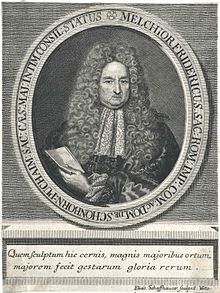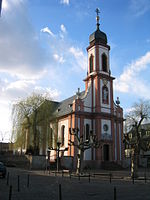Melchior Friedrich von Schönborn-Buchheim
Count Melchior Friedrich von Schönborn-Buchheim (born March 16, 1644 in Groß-Steinheim near Hanau ; † May 19, 1717 in Frankfurt am Main ) was a German nobleman, imperial privy councilor and chamberlain, and minister of state of Mainz. He came from the Schönborn house . After his death, four of his sons became German prince-bishops.
resume
Melchior Friedrich, baron (until 1701) by Schönborn, first worked at the direction of his uncle and later guardian, Elector of Mainz and Archbishop Johann Philipp von Schönborn (1605 to 1673), as Electoral Mainz envoy in Liege , The Hague , Königsberg , Dresden , the Aachen Congress and the Cologne Electoral Congress , before he was Vice-Domus of Aschaffenburg from 1672 to 1700 . He also became imperial privy councilor and treasurer, Elector of Mainz State Minister, Obermarschall von Mainz and Würzburg , inheritance of Kurmainz , hereditary seat of Würzburg, since August 5, 1701 imperial count, after adoption on February 19, 1711 he called himself Schönborn-Buchheim (see below) since July 1, 1709 a member of the Bohemian nobility, since January 22, 1710 a member of the nobility of Lower Austria, from 27 April 1711 Adel member of upper Austria, since 1720 Inkolat in Styria and Carinthia, February 19 1711 Old Mr. booth,
wife
He was married to Maria Anna Sophia Johanna Freiin von Boineburg and Lengsfeld (* October 16, 1652; † April 11, 1726), daughter of Johann Christian von Boyneburg , who bore him 18 children, four of whom died young. Four sons of this marriage became Prince Archbishops with large sources of income, Johann Philipp Franz von Schönborn in Würzburg, Friedrich Karl von Schönborn in Würzburg and Bamberg, Franz Georg von Schönborn in Trier and Worms and Damian Hugo Philipp von Schönborn-Buchheim in Speyer and Konstanz. Another son was Rudolf Franz Erwein von Schönborn , Vice Cathedral of Aschaffenburg and imperial secret council. His second son, Friedrich Karl, who later became the Prince-Bishop of Würzburg and Bamberg, was Vice Chancellor in Vienna for Emperors Joseph I and Karl VI while his father was still alive . from 1705–1731 the Reichshof Chancellery , the highest authority of the Holy Roman Empire.
The daughters married into respected noble families. Amalia Anna Elisabeth, for example, married General Otto Ernst Leopold von Limburg-Stirum and they were the parents of the later Prince-Bishop of Speyer, Damian August Philipp von Limburg-Stirum .
parents
His father, the Electorate Mainz bailiff Philipp Erwein von Schönborn (1607–1668), who died early , was the only brother of the Mainz Elector and Archbishop Johann Philipp von Schönborn (1605–1673), who was Archbishop of Mainz for 26 years (from 1647), 31 He was Bishop of Würzburg for many years (from 1642) and Bishop of Worms for 10 years (from 1663). This brother Johann Philipp, later famous as the German Solomon , is one of the most important archbishops of the Archdiocese of Mainz and was the patron of the family. It was also he who first appointed his father, Philipp Erwein von Schönborn, to the Electorate of Mainz in Steinheim, where Melchior Friedrich was born on March 16, 1644. Later the brother was assigned offices and titles to Philipp Erwein, such as the inheritance of the Archbishopric Mainz and the inheritance of the Bishopric Würzburg.
His mother was Maria Ursula, geb. Greiffenclau von Vollrads (* July 15, 1612; † August 28, 1682), a niece of the Elector and Archbishop of Mainz Georg Friedrich von Greiffenklau (1573–1629), who died in 1629 . The influential families von Eltz and von der Leyen were also related . They had 12 children, 7 daughters and 5 sons.
Possessions
In 1654, his father Philipp Erwein von Schönborn (1607–1668) had acquired the noble residence of the Stockheim zu Geisenheim family from 1550 , which later became Schönborn Castle . On August 30, 1661 Philipp von Schönborn Erwein had the Count of Heusenstamm its domination bought. He had the old castle, which was partially destroyed in the Thirty Years' War, restored and from 1663 to 1668 a front castle built in the Renaissance style in the forecourt of the old castle, which was initially planned as a four-wing moated castle. The servants were now able to partially inhabit the restored lock at the rear. In keeping with his status, he, now also Erbtruchsess von Würzburg, appointed Imperial Count since August 5, 1701, then also in Mainz, the seat of his brother of the ruling elector and archbishop, the construction of the Schönborn Court in Mainz from 1668–1670, which he however completed no longer lived.

The Schönborner Hof (Aschaffenburg) , a city palace, was built from 1673 to 1681 as the Aschaffenburg residence for the Mainz Obersthofmarschall and Vizedom Melchior Freiherr von Schönborn and his wife Sophia Maria Anna. It was built according to the designs of the Capuchin Father Matthias von Saarburg from Mainz . Since Melchior Friedrich became increasingly wealthy, especially in the Aschaffenburg area , he gave up his previous residence in Schönborn Castle in Heusenstamm in favor of his son Anselm Franz von Schönborn , Buchheim and Wolfsthal (1681–1726), which was still owned by his father Philipp Erwein von Schönborn (1607–1668) was built.
Schönborn-Buchheim

1710 bought Melchior Friedrich of the last Count of Puchheim (see. Also Schloss Puchheim ), Franz Anton von Bucheim, the then Bishop of Wiener Neustadt , the gentlemen Göllersdorf , Mühlberg and Aspersdorf in Lower Austria . With the purchase the entry into the Austrian nobility was connected. The seller then alternately called itself Puchheim-Schönborn, the buyer family from then on called Schönborn-Puchheim, later Schönborn-Buchheim. The Austrian title of Count was also awarded to his father, Melchior Friedrich Graf von Schönborn.
The existing castle in Göllersdorf (Weinviertel) was cleared after the construction of the new Schönborn castle and later sold; Today the Republic of Austria operates the Göllersdorf prison on the grounds of the palace . From 1711–1718, shortly after the purchase, Melchior Friedrich commissioned the architect Johann Lukas von Hildebrandt to convert the Mihlberg fortress on the property into a representative country palace. A three-wing complex with an extensive garden, orangery and palace chapel was built southeast of the village. Hildebrand built a monumental Johannes Nepomuk chapel on the north-western edge of the extensive palace gardens from 1729–1733 . The castle is still owned by the family (Friedrich Karl Schönborn-Buchheim senior). A golf course was opened in the castle park in 1989 and has won international awards. Two thirds of the facility are located in the palace park area and fit harmoniously into the historic park area. The Schloß Schönborn Golf Club uses the castle as a club house for the corresponding golf course .
In 1715, Imperial Vice Chancellor Friedrich Karl Graf Schönborn also acquired the nearby Weyerburg rulership in Lower Austria / Weinviertel - about 10 km east of Hollabrunn - from the property of Baron Dominikus von Hochburg.
His burial place
The crypt of the parish church St. Cäcilia (Heusenstamm) was built from 1739 to 1741 as a Catholic burial church of the Heusenstammer branch of the Counts of Schönborn by the master builder Johann Balthasar Neumann . It is the most important baroque building in the Hessian Heusenstamm . Here are the remains of 9 people in 8 graves of the Heusenstammer Schönborn line, including the Freiin von Boineburg and Lengsfeld (1652–1726) born by Melchior Friedrich von Schönborn and his wife Maria Anna Sophia Johanna.
literature
- Constantin von Wurzbach : Schönborn, Melchior Friedrich Graf . In: Biographisches Lexikon des Kaiserthums Oesterreich . 31st part. Imperial-Royal Court and State Printing Office, Vienna 1876, p. 139 ( digital copy ).
- Friedrich Josef Krappmann: Melchior Friedrich von Schönborn and the Mainz policy from 1665–1673 Karlsruhe, Braun-Verlag, 1931, 35 pages; University of Würzburg, dissertation, July 10, 1929
Web links
- Melchior family Friedrich Graf von Schönborn
- Vita of Melchior Friedrich Graf von Schönborn
- Steinheim Castle near Hanau
- Steinheim Castle Hesse
- Heusenstamm Castle
- History of the extension of the name Schönborn-Buchheim
- Entry via Weyerburg Castle (owned by Count Schönborn-Buchheim) on Burgen-Austria
| personal data | |
|---|---|
| SURNAME | Schönborn-Buchheim, Melchior Friedrich von |
| BRIEF DESCRIPTION | German nobleman, imperial privy councilor and chamberlain as well as Electoral Mainz minister of state |
| DATE OF BIRTH | March 16, 1644 |
| PLACE OF BIRTH | Groß-Steinheim near Hanau |
| DATE OF DEATH | May 19, 1717 |
| Place of death | Frankfurt am Main |

